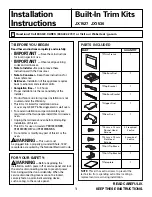
TL46-WLF
Contrast sensor
INSTRUCTION MANUAL
CONTROLS
OUT LED (yellow)
The yellow LED indicates the output status.
DISPLAY (green 4-digit display)
During normal functioning, the display indicates a value
relative to the light quantity diffused by the target.
READY LED (RDY)
The green READY LED ON indicates a normal operating
condition where the received signal has a safety margin
respect to the output switching value: stability condition.
DELAY LED
The green DELAY LED ON indicates the timing activation on the digital
output.
KEYLOCK LED
The green KEYLOCK LED ON indicates the active keyboard status.
(white),
(red), and
(green) PUSH-BUTTONS
See the “SETTING” paragraph for the correct adjustment phase indications.
INSTALLATION
The sensor can be positioned by means the two
Ø3.5
mm housing’s holes
using or threaded M5 holes with 6mm max. depth.
Warning:
the use of excessively long screws can damage the product.
The connector can be oriented at five different positions by rotating the block.
The position chosen is guaranteed by a mechanical blocking system.
The rotation can be carried-out even after sensor installation as the connector
block is completely self-contained inside the housing.
The operating distance is measured starting from
the lens front face.
The reading direction can be changed inverting
the cap and lens.
Mark detection on a reflective surface is
improved adjusting the beam direction to 5° …
20° from surface axis.
CONNECTIONS
DIMENSIONS
TECHNICAL DATA
Power supply:
10…30 Vdc limit values
Ripple:
2 Vpp max.
Current consumption
(output current excluded):
35 mA max. @ 24 Vdc
Output:
1 selectable PNP/NPN output
30 Vdc max. (short-circuit protection)
default PNP configuration
Output current:
100 mA max.
Output saturation voltage:
2 V
Response time:
16
s
Switching frequency:
30 kHz
Indicators:
4-digit display (GREEN) / OUT LED (YELLOW) /
READY LED (GREEN) / DELAY LED (GREEN) /
KEYLOCK LED (GREEN)
Push-buttons:
push-buttons : -, SET, +
Delay
0…100 ms programmed
default configuration without delay
Dark/light selection:
Automatic in the target/background detection
selectable via wire in the dynamic detection
Operating temperature:
-10 … 55 °C
Storage temperature:
-20 … 70 °C
Electric shock protection:
double insulation
Operating distance:
9 mm
Depth of field:
3 mm
Minimum spot dimension:
1.5x5 mm
Emission type:
blue ( 465 nm) / green (520 nm) / red (630 nm)
with automatic selection
Ambient light rejection:
according to EN 60947-5-2
Vibrations:
0.5 mm amplitude, 10 … 55 Hz frequency,
for each axis (EN60068-2-6)
Shock resistance:
11 ms (30 G) 6 shocks for each axis (EN60068-2-27)
Housing material:
Aluminium
Lens material:
Glass (
*
)
Mechanical protection:
IP67
Connections:
M12 5-pole connector
Weight:
170 g. max.
(
*
)
It’s available on request, PMMA plastic lens with 9mm focus.
SETTING
KEYLOCK FUNCTION (PATENT-COVERED)
The KEYLOCK function deactivates the keyboard avoiding any accidental
changes in sensor setting.
At sensor powering, the keyboard is blocked (KEYLOCK LED OFF).
The
push-button has to be pressed for 5 sec. until the KEYLOCK LED
turns ON. The keyboard is blocked automatically if not used for 2 minutes.
The keyboard has to be unlocked to proceed with sensor setting.
DETECTION (MARK-BACKGROUND)
-
Position mark in front of the sensor light spot
and press the
push-button until the ‘SEt1’
text appears.
The sensor detects the mark alternating the
red, green and blue emissions.
Avoid mark movements until the ‘SEt2’ text
appears and the OUT LED blinking.
- Position the background in front of the sensor light spot and press the
push-button again. The sensor detects the background and automatically
selects the best emission to detect the
contrast.
Avoid background movements during this
phase.
The DARK/LIGHT operating mode is
automatically selected by the sensor.
Dark mark - light background
dark mode;
light mark - dark background
light mode.
If the detection has been successful, the sensor
returns to normal functioning. If it fails due to
insufficient contrast, the ‘FAIL’ test blinks on the
display. Press the
push-button and the
sensor returns to the previous setting.
Repeat the procedure from the beginning.
DYNAMIC SETTING
Use the dynamic setting to detect moving target. The sensor sets
automatically the threshold value during target movement. The DARK/LIGHT
mode has to be previously set. To select the light mode connect the
DARK/LIGHT signal (white wire) to 0V or leave unconnected. To select the
dark mode connect the DARK/LIGHT signal to the power supply.
-
Position the sensor spot in front of
the target to detect. Press
until
the
‘dYn’ text blinks (4sec) and keep
it pressed. The sensor detects the
mark and automatically selects the
best emission to detect the contrast.
-
To end the dynamic detection
procedure release the
push-
button.
If the detection has been successful,
the sensor returns to normal
functioning. If it fails due to insufficient
contrast, the ‘Lo’ test blinks on the display. Press the
push-button to
repeat procedure until releasing the button (the ‘dYn’ text blinks on the
display). The sensor returns to the previous setting by pressing
or
.
SWITCHING THRESHOLD SETTING
The sensor switching threshold can be adjusted in this manner.
The ‘AdJ’ text appears pressing
on the display. Releasing the push-
button, the threshold value blinks.
The switching threshold is increased or reduced by pressing
or
.
Press
to save the new threshold value.
HYSTERESIS SETTING
The sensor hysteresis level is adjusted.
The ‘HYSt’ text appears pressing green
on the display.
Releasing the push-button the previously set value blinks.
HIGH HYSTERESIS
NORMAL HYSTERESIS
LOW HYSTERESIS
The level switches by pressing
or
.
Press
to save the new hysteresis value.
OUTPUT OVERLOAD
The overload of the digital output is signalled by the ‘_SC_’ text on the
display. The sensor return to normal working when the overload condition
disappears.
PARAMETER SETTING
Some parameters can be changed entering in the menu: DELAY ON, DELAY
OFF, PNP/NPN switching output, display orientation and powering on/off of
the display.
Press
and
contemporarily until the ‘Menu’ text appears.
Releasing the push-button, the first Delay ON parameter appears.
The parameter list is visualised by pressing
and
:
DELAY ON setting
The DELAY ON represents the output delay activation after the reference
mark has entered in the detection area. The delay avoids the detection of
events that occur rapidly. An example can be a mark with shaded colours
(light-dark-light) that can be detected twice.
Select “dLOn” in the parameter menu to set the DELAY ON function.
The parameter programming is accessed by pressing
.
The previously set delay value appears on the display.
Pressing
or
the delay value is increased or decreased by one step of
1 ms until a maximum delay of 100ms. Keeping press
or
the delay
value is increased or decreased by incremental step. The setting of a delay
different from zero is signalled by the DELAY LED on. Press
to confirm
the value and return to the parameter menu.
DELAY OFF setting
The DELAY OFF represents the output delay deactivation after the reference
target has left the detection area.
The delay extends the output activation allowing slower system interfacing
with sensors to detect shorter pulses.
Phone: 800.894.0412 - Fax: 888.723.4773 - Web: www.clrwtr.com - Email: [email protected]




















